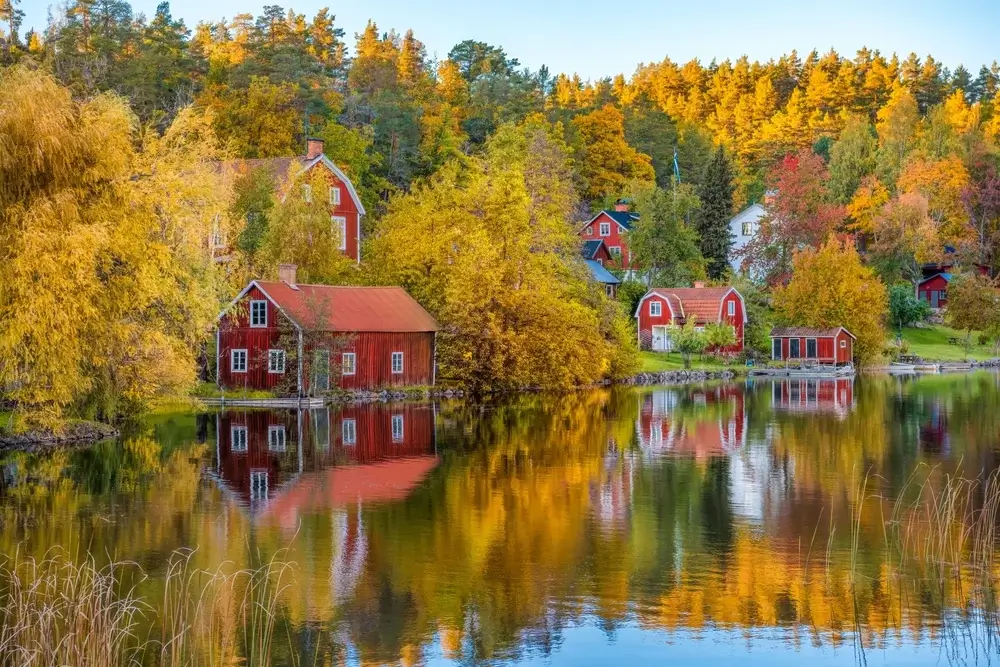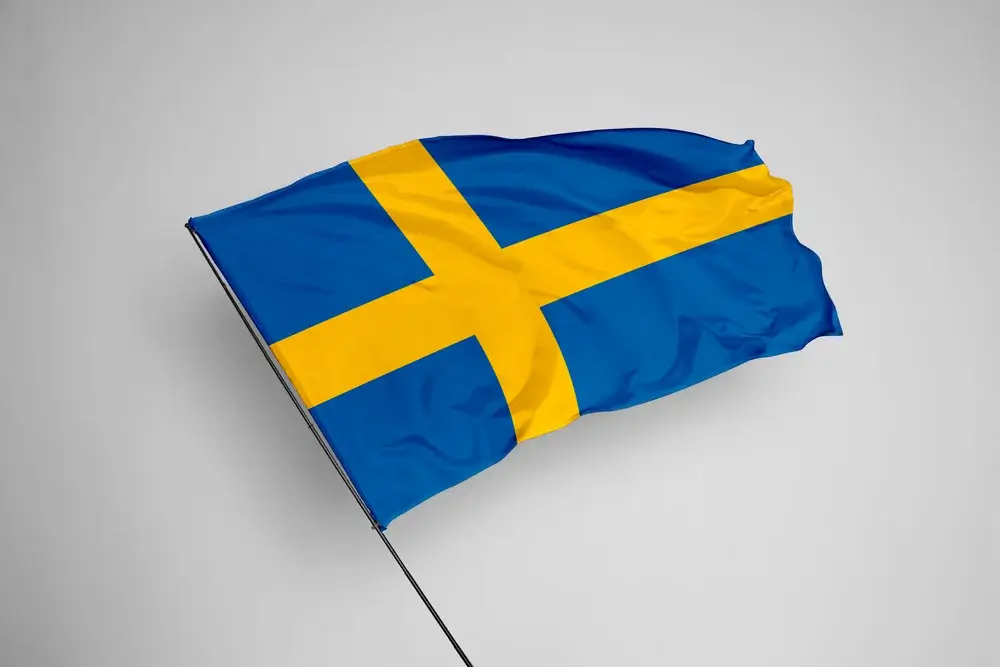Sweden
Sweden Country Guide

Think of a colorful city with numerous natural landscapes, forests, and lakes. Cold in general, but can be mildly hot during summer months. Sweden is one of these countries in the world, and it has such a unique climate that it won’t make you sweat that easily. Visiting a Nordic country is always a unique experience everyone should taste once in their life. Now imagine staying in one of the hotels in Sweden with a beautiful view of the color palette outside, the sun going down slowly while you enjoy that very moment. Nothing could be better than that and as Bookperfect, we want you to feel like that when you visit another country. For this reason, we listed all the best Sweden hotels of your choices. Whether it’s the popular Icehotel Jukkasjärvi or more affordable like Generator Stockholm, you can find every type of hotels in Sweden at ease on our platform. Now, if it’s going to be your first time traveling to Sweden, don’t worry because we got you covered! Here, you can find everything you need to know about Sweden. Think it as a country guide. Without further ado, let’s start our Sweden tourist guide!
Things To Know Before Going To Sweden
- Sweden is largely cashless, so make sure to have a credit/debit card that works abroad. Many places won't accept cash.
- Driving in Sweden can be tricky. Swedes look both ways at junctions and use indicators, or exit roundabouts consistently. Be extra cautious.
- Winters are long, dark, and can be depressing. Use a happy lamp and take vitamin supplements to combat the gloom.
- Summers are glorious but also intense.
- February is the worst time to visit weather-wise unless you plan to go skiing.
- June is ideal for seeing Sweden at its best.
- Swedes value personal space and aren't always eager to strike up conversations with strangers.
- Smoking is prohibited indoors and in many outdoor areas like train platforms.
- Bring food you like if you're picky, as Swedish cuisine may not suit all tastes.
- Try traditional Swedish treats like semla (a seasonal pastry) and cardamom buns.
- Coffee culture is huge.
- Stockholm is a must-see, with its beautiful old town, archipelago day trips, and vibrant food scene.
- Gothenburg and Malmö are other major cities worth visiting.
- For nature lovers, the hiking trails in northern Sweden and islands like Gotland are stunning.
Local Tips For Sweden
- Most people in Sweden tend to be aversive. If you go up to strangers, whom you do not know and strike up a conversation, that’s a gamble.
- Don’t force sit next to someone on a train, or a bus unless it’s the only seat.
- You don’t need to tip.
- Don’t hug, kiss, pat on the back or do anything physical to strangers in Sweden.
- Buy your train tickets before you get on the train and show them to local conductors in a routine check.
- Don’t haggle. A set price is a set price in Sweden.
- 3 days is a good amount for Stockholm
- Consider day trips to explore more areas
- Spend 1.5-2 days on typical tourist attractions
- Spend a day in the archipelago
- Renting a sailing/motorboat offers a full experience but may be costly
- Consider a tour to Sandhamn, especially post-summer for quieter experience
- With 6 days, consider basing in Stockholm and doing day trips
- Try to combine visits to Sigtuna, Uppsala, and other nearby attractions
- West Coast is great in summer and autumn but may not fit the timeframe
Is Sweden Expensive To Visit?
While Sweden is not the cheapest destination, it is the least expensive among the Scandinavian countries. Eating at basic restaurants like McDonald's or buying sandwiches from grocery stores can cost around 150-200 SEK (approximately $17-22 USD) per meal. Train travel can be expensive, especially for longer distances. Booking tickets in advance can help reduce costs. If you're staying with friends or family, accommodation costs can be significantly lower. Otherwise, budget for hotel or hostel prices.
Overall, a daily budget of $150 would allow you to feel relatively free to do most activities in Sweden, excluding high-end dining or luxury experiences.
Is Visiting Sweden Worth It?
Yes, visiting Sweden is worth it. Sweden has beautiful natural landscapes, including national parks and archipelagos. These can be accessed by ferry or train, and offer a unique experience. Visiting medieval towns like Visby on the island of Gotland can be a memorable experience. However, if you’re on a budget and want to explore most of the city, you may have hard time as it’s not the cheapest country in Europe.
Is Sweden Safe For Tourists?
As a whole, Sweden is very safe. In fact, most residents of Sweden report that they always felt safe as long as they were not in gang areas or in suburbs during the night. Rinkeby, Rågsved, Tensta, Farsta, Farsta Strand, Hässelby, Hässelby Strand, Flemingsberg, Fittja, and parts of Huddinge Kommun are considered vulnerable due to gang violence and petty crime. However, it is important to note that these areas are not necessarily dangerous for tourists or visitors, and most crimes are between rival gang members rather than targeting random individuals
Best Cities in Sweden
Here’s your fast Sweden city guide depending on where city you are planning to visit:
City Name | Best For | Best Attractions | Average Trip Cost |
| Stockholm | Cosmopolitan culture History Nature | Gamla Stan (Old Town) Vasa Museum ABBA Museum Stockholm Archipelago | $150-300 per day |
| Gothenburg | Coastal charm Seafood Laid-back atmosphere | Haga District Feskekörka Fish Market Canal tours | $120-250 per day |
| Malmö | Diverse culture Architecture Beaches | Turning Torso Skyscraper Gamla Staden (Old Town) Kungsparken | $100-200 per day |
| Uppsala | History Academia Student life | Uppsala Cathedral Gustavianum Museum Botanical Gardens | $90-180 per day |
| Lund | Charming university town Medieval architecture | Lund Cathedral Historical Museum Lundagård park | $80-160 per day |
| Kiruna | Northern Lights Winter activities | Abisko National Park Icehotel Kiruna Mine | $120-250 per day |
| Visby | Medieval history Beaches | Visby City Wall Visby Cathedral Gotlands Museum | $100-200 per day |
| Helsingborg | Coastal scenery Culture | Kärnan medieval tower Harbor Promenade Sofiero Palace | $90-180 per day |
| Örebro | Outdoor activities Student life | Örebro Castle Lake Vänern Parks | $80-160 per day |
| Karlstad | Lake activities Student culture | Lake Vänern Klarälven River Bars and restaurants | $70-140 per day |
Must-See Sweden Attractions
As one of the greatest natural wonders, Sweden attractions have lots of things to offer to their visitors. From amazing landmarks to beautiful scenes, attractions in Sweden know how to keep you delighted. Here are some of the top Sweden attractions you should see during your trip:
- Gamla Stan, Stockholm: The historic old town of Stockholm, known for its medieval architecture and narrow cobblestone streets.
- Vasa Museum, Stockholm: A maritime museum housing the well-preserved 17th-century warship Vasa.
- Drottningholm Palace, Lovö: A UNESCO World Heritage Site and the private residence of the Swedish royal family.
- The Göta Canal, Gothenburg to Stockholm: A scenic waterway connecting Gothenburg and Stockholm, popular for boat tours and cycling paths.
- Kiruna and the Ice Hotel, Lapland: A unique hotel constructed entirely of ice and snow, rebuilt each winter.
- Skansen and Djurgården, Stockholm: An open-air museum and zoo showcasing Swedish cultural history and native wildlife.
- Visby, Gotland: A medieval town with well-preserved city walls and ruins, often called the "City of Roses."
- Stockholm City Hall: An iconic building known for its architectural beauty and the venue for the Nobel Prize banquet.
- Liseberg Theme Park, Gothenburg: Scandinavia’s largest amusement park, featuring a variety of rides and attractions.
- Kärnan & the Fredriksdal Open-Air Museum, Helsingborg: A historic medieval tower and a museum showcasing traditional Swedish rural life.
- Oresund Bridge, Malmö: A combined railway and motorway bridge linking Sweden with Denmark.
- Domkyrka, Uppsala: The largest cathedral in Scandinavia, renowned for its Gothic architecture.
- Sigtuna: Sweden's oldest town, rich in history and Viking-era runestones.
- Stockholm Archipelago, Stromma Boat Tours: A vast network of islands perfect for exploring by boat tours.
- Abisko National Park, Lapland: A natural park known for its stunning landscapes and the Northern Lights.
The Best Time To Visit Sweden
Mid-June to mid-August is generally considered the nicest time to visit Sweden. The weather is warm and sunny, with long daylight hours. The sun doesn't set at all in parts of northern Sweden. Midsummer in late June is a huge national holiday with celebrations. Summer is the safest bet for good weather, although it's never guaranteed. However, crowds are higher in summer, especially in popular destinations like Stockholm.
If you enjoy snow activities like skiing and snowmobiling, winter is a good time to visit northern Sweden. Christmas is a beautiful time with snow and festive decorations. Avoid Malmö in winter as the weather can be depressing, rainy, and wet.
March to May and September to November can also be nice times to visit, with fewer crowds and lower prices compared to summer. However, the weather is more unpredictable, but can still be pleasant. Some attractions may have reduced hours or be closed in early spring or late fall.
Where is Sweden?
Sweden is a Nordic country located on the Scandinavian Peninsula in Northern Europe. It lies west of the Baltic Sea and Gulf of Bothnia, providing a long coastline, and forms the eastern part of the Scandinavian Peninsula. To the west is the Scandinavian mountain chain (Skanderna), which separates Sweden from Norway. Finland is located to its north-east. Sweden also has maritime borders with Denmark, Germany, Poland, Russia, Lithuania, Latvia, and Estonia, and is linked to Denmark by the Öresund Bridge.
What is the Capital of Sweden?
The capital of Sweden is Stockholm, which is located on the eastern coast of the country, where Lake Mälaren flows into the Baltic Sea. Stockholm is situated on the islands of Gamla Stan (Old Town) and Södermalm.
Languages Spoken in Sweden
The official language of Sweden is Swedish which is spoken by the majority of the population. It is a North Germanic language and shares similarities with Norwegian and Danish. In northern regions, Finnish and Sámi languages are spoken, and German in urban parts of the country. When it comes to English, most of the population knows well enough to hold the conversation.
Time Zone of Sweden
Sweden has a single time zone, which is Central European Time (CET) during standard time and Central European Summer Time (CEST) during daylight saving time. The time zone is UTC+1 during standard time and UTC+2 during daylight saving time.
What Currency Does Sweden Use?
Sweden uses the Swedish krona (SEK) as its official currency. Sweden has its own currency despite being a member of the European Union, as it has not adopted the euro.
Sweden Flag

The flag of Sweden is a national symbol that consists of a yellow or gold Nordic cross on a field of light blue. The Nordic cross design traditionally represents Christianity. Blue represents the sky and the countless lakes of Sweden, symbolizing vigilance, truth, loyalty, perseverance, and justice. Yellow (gold) represents generosity, the sun, and prosperity, reflecting the historical wealth of the Swedish kingdom and the warmth and light that the sun brings to the country.
Population of Sweden
According to the latest data, the current population of Sweden as of June 2024, is 10,673,669. Sweden has a low population density of 26 inhabitants per square kilometer. Around 87% of the population lives in urban areas. The three largest cities in terms of population are Stockholm (952,058), Gothenburg (565,496), and Malmö (351,749). Sweden has an aging population, with an average age of 41.1 years. 26% of the population is of foreign background, defined as being born abroad or having both parents born abroad
Strange Laws in Sweden
- It`s illegal to wear a mask in public unless it`s for a traditional celebration or for a theatrical performance.
- There are restrictions on naming your child in Sweden to prevent causing offense or discomfort.
- Running out of gas on the highway in Sweden can result in a fine due to the traffic hazard it creates.
- Wearing swimsuits in public spaces in Sweden is prohibited except for designated beaches and swimming areas.
- Fines can be imposed for not including your home address on your website in Sweden to ensure transparency and accountability.
- In certain areas of Sweden, permission from neighbors is required before painting your house a new color to maintain aesthetic harmony.
- Homeowners in some municipalities in Sweden can be fined for not shoveling the snow outside their property to ensure public safety.
- Flying drones in Sweden is regulated, with restrictions near airports, over people, and in sensitive areas to ensure safety and privacy.
- Fines can be imposed in Sweden for not sorting recyclables properly due to the country’s strong environmental policies.

